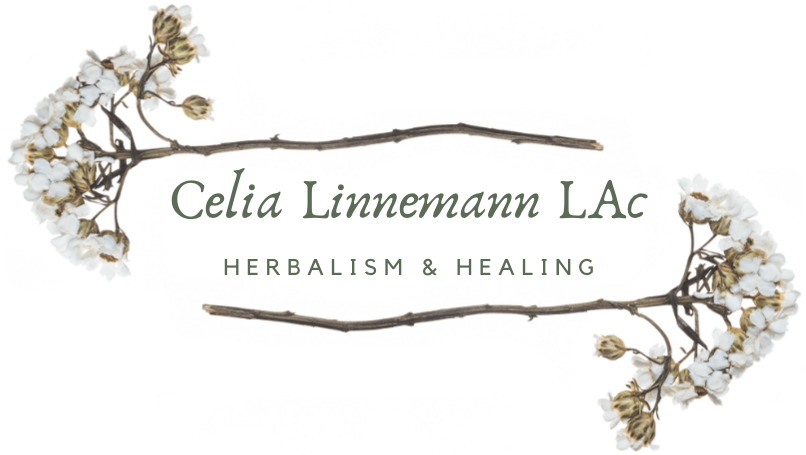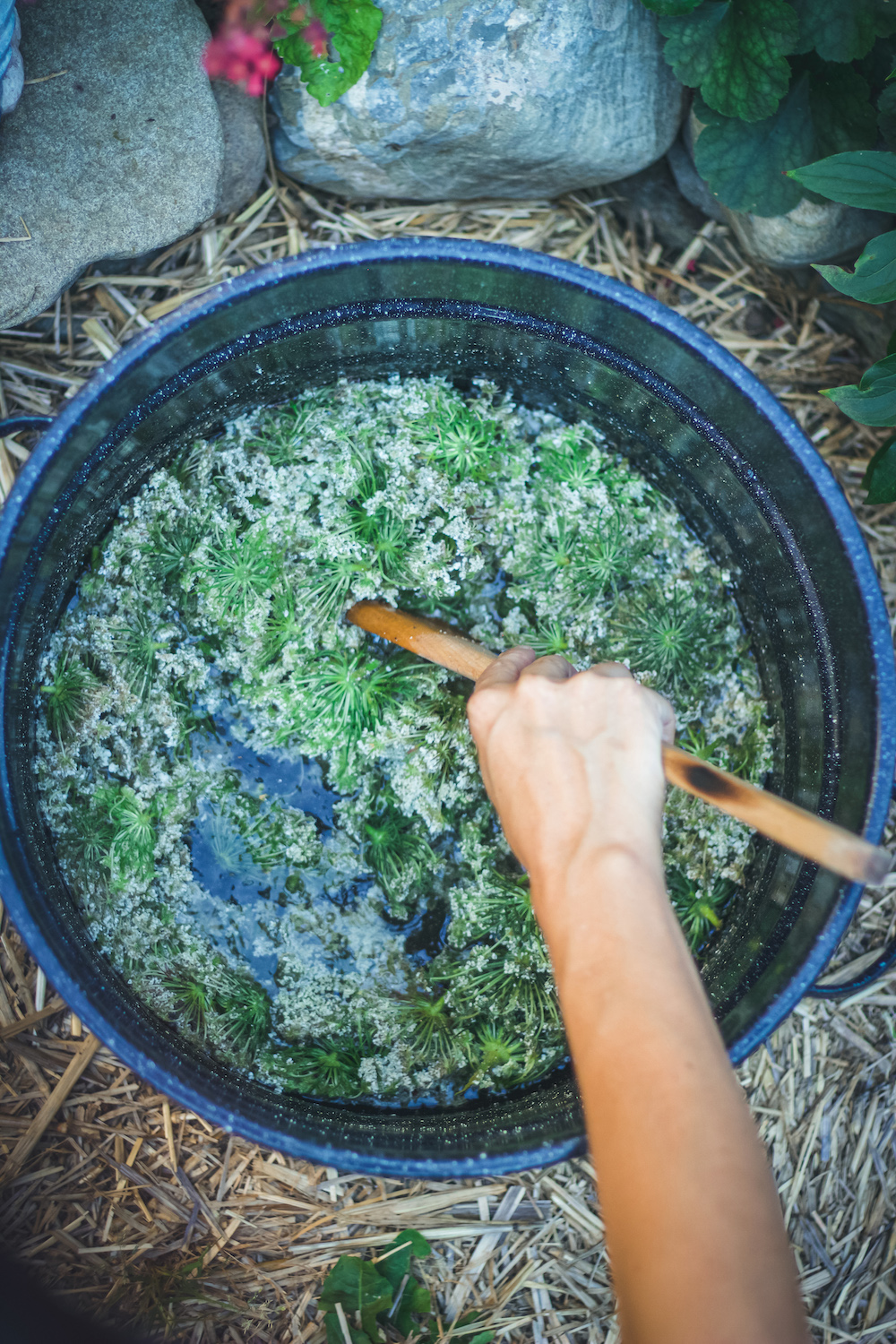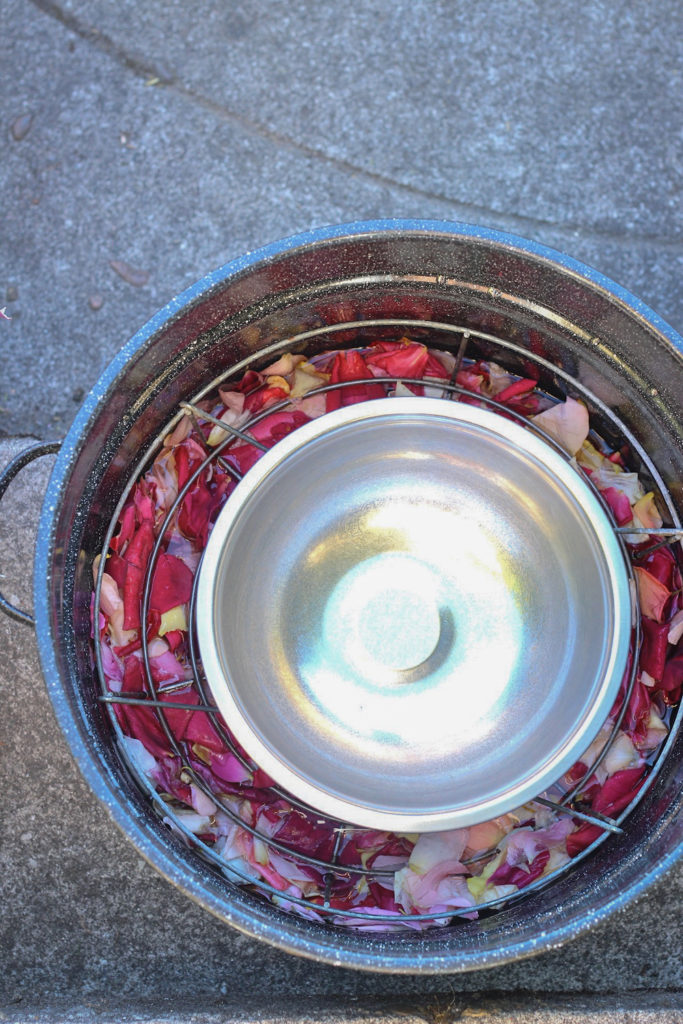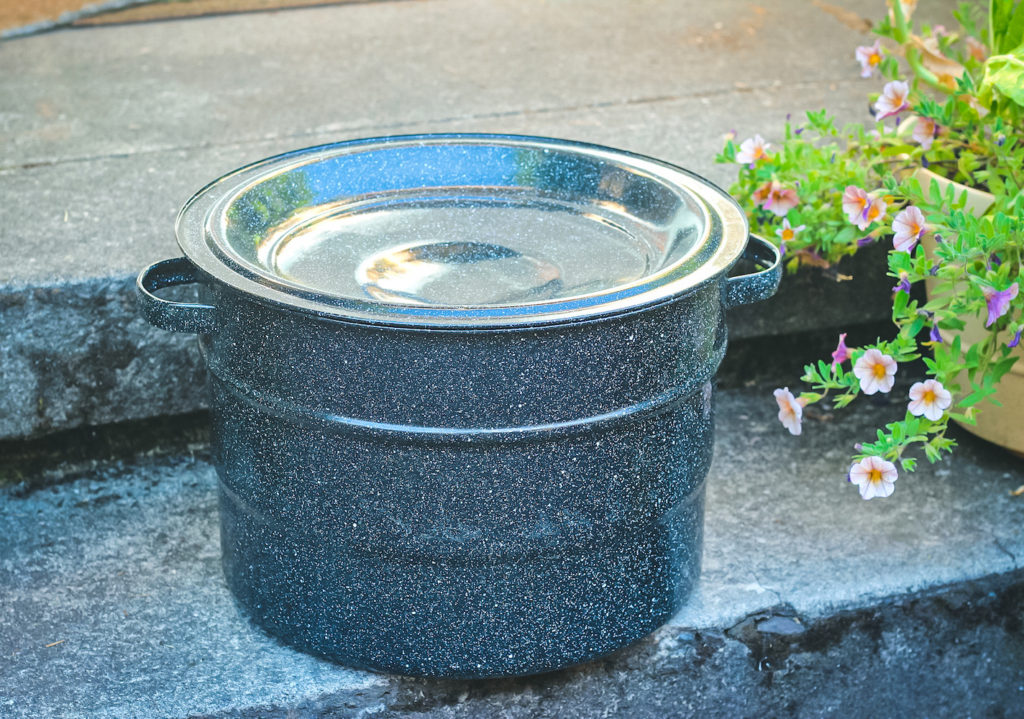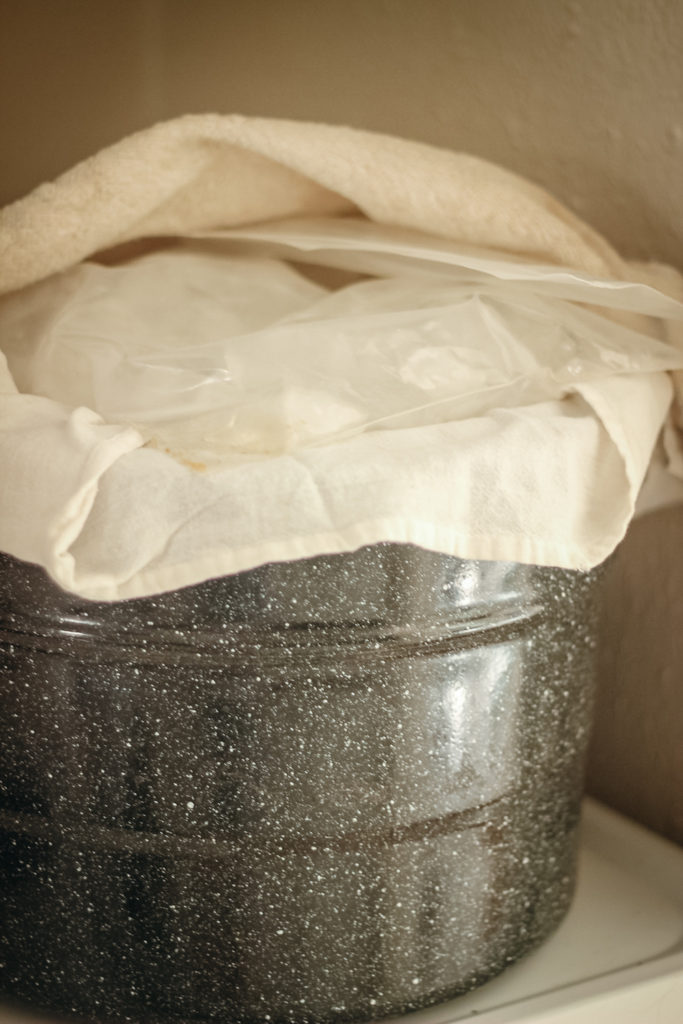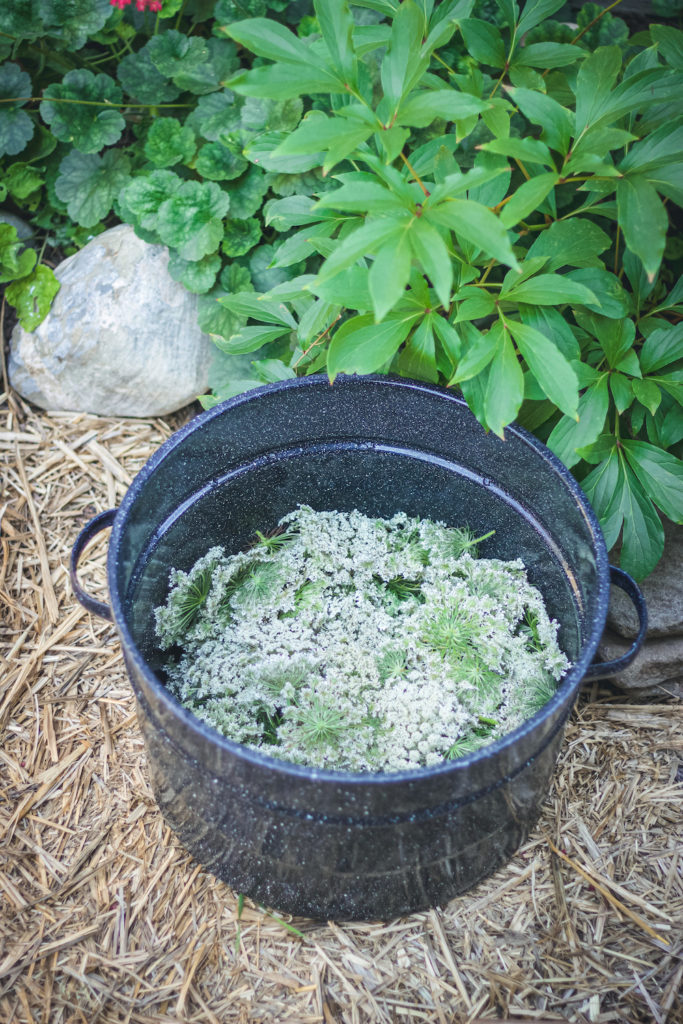How to Make a Hydrosol with a Canner
Have you ever made a hydrosol with a canner?
You don’t need a fancy copper still to make fabulous hydrosols. A home canner with the macerated herbs in the bottom, a bowl to catch the distillate, and a few bags of ice on the inverted lid to help condensation works pretty darn well.
In case you don’t know, a “canner” is a pot large enough that you can immerse quart jars (tiny jars, too) in boiling water to get them to seal. For making jam, stewed tomatoes, canned pears, pickles – that sort of thing.
Canners are relatively cheap. Even if you don’t make jellies and jams and stewed tomatoes, it is easy to justify buying a canner because you can use them to make some badass hydrosols.
Of course, I’d love to have a distiller, but if you’re like me and aren’t there yet, don’t let that stop you from the pure magic of creating your own hydrosols.
In this post I am going to go over a super easy way to make a hydrosol with a home canner, using Wild Carrot / Queen Anne’s Lace as my example – and a few pictures of a Rose hydrosol thrown in for good measure.
This summer was the Summer of Herbal Favorites for me. I made a handful of my favorite herbal remedies. Lavender herbal oil, for one. Hypericum/St. Johns oil, for another.
And yet another was Queen of Hungary’s Water, an herbal vinegar used to make a botanical toner. One of the imperative parts of making a botanical toner is Wild Carrot hydrosol, which means I’m almost ready to create a new batch of toner.


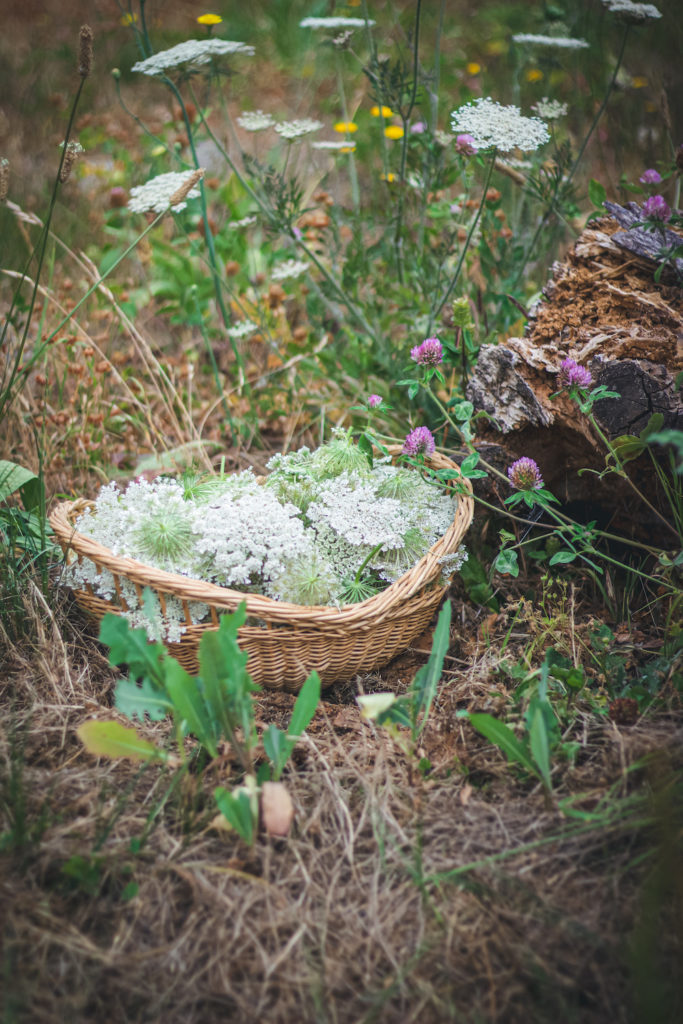
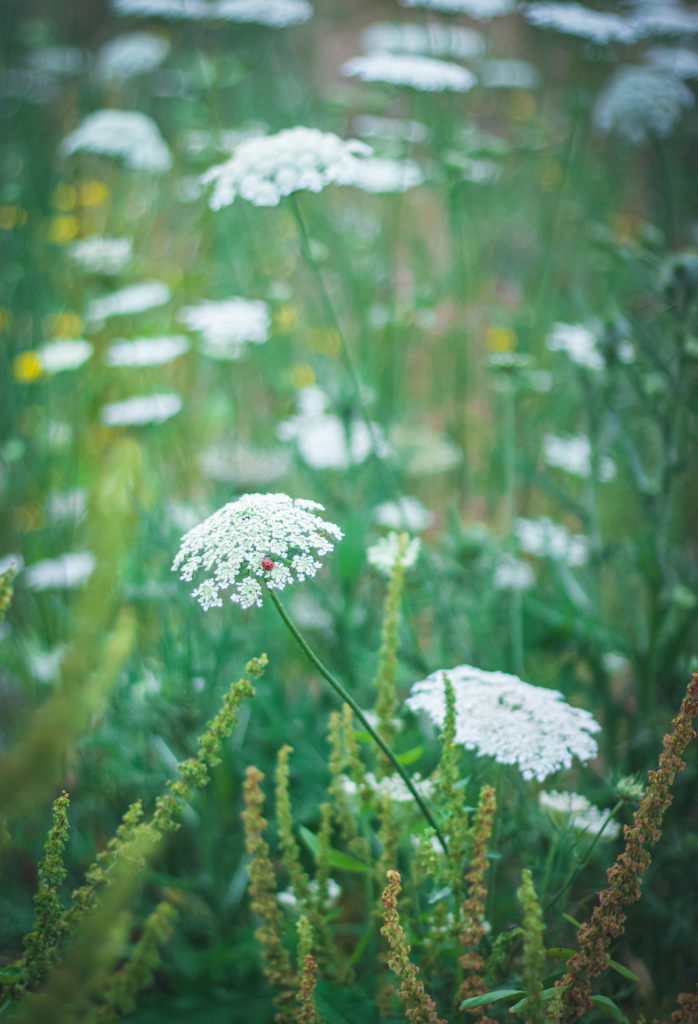
Endless Aromatic Possibilities
Making a Wild Carrot hydrosol is a great reason to harvest a bagful of lacy death tops (as I called them as a kid) and seedy birds nests.
A brilliant excuse for a mid morning spent with the bees, knee deep in pockets of weedy wildness.
I use Wild Carrot for its medicinal purposes as an emmenagogue, but not that frequently. Because of their limited use in my practice, making hydrosols are the main way I have the privilege and honor to engage with this plant (who also makes a nice Flower Essence, too).
The possibilities for creating a hydrosol are endless. I’ve used all sorts of mint family plants, citruses, Apiaceae family plants like Dill, Fennel, Angelica and of course Wild Carrot, Calendula and Chamomile.
I have not yet made a hydrosol from evergreen trees like Fir or Pine, but would love to. We have a lot of Bay around here that I cannot get enough of smelling. Bay is a favorite of mine for ritual and cleansing, too, so I imagine spraying Bay in the air would be quite refreshing. Keep in mind that Bay is a little toxic internally, so a Bay hydrosol would be for environmental and occasional external use only.
Another hydrosol on my fantasy list is Yarrow. The Azulreline in Yarrow turns this hydrosol a clear blue.
Some of the photos are from a time when I made a Rose hydrosol – that was quite lovely too.
Uses of Hydrosols
To be clear, hydrosols are part of the essential oil process but they are not essential oils. (A couple a weeks ago I wrote that herbal oils are also not essential oils).
Hydrosols do contain volatile oils that become a part of essential oils, but they also contain water-soluble compounds (which are absent in essential oils). They are much more mild and gentle than essential oils because of the larger array of both oil and water soluble compounds.
The uses of hydrosols are wide ranging. I trust their safety, balanced effects and sustainability more than using essential oils.
Plus, hydrosols are easy to make yourself. True, essential oils can be distilled with special equipment, but the privilege to have access to the equipment and the huge amount of plant material needed to make essential oils is a barrier. Hydrosols though – anyone can do it.
We can make a relationship to the aromatic nature of these plants without all the waste, cost, resources, and potential toxicity.
Ways to use a hydrosol
- Internal Use: Flavoring for confection, drinks, concoctions, syrups, and so on. Example: Rose Water in Baklava, rice puddings, Lassis
- Environmental: Spray around a room to diminish ill effects of forced-air dryness; also for cleansing and protection of a space. Example: Lavender hydrosol for an all around cleansing effect of a room.
- Ritual: As a convenient spritzer addition or substitute for cleansing, protection, anointment; Water, Air or Fire rituals; mixed with other plant extracts and gem or flower essences, charged under a particular type of moon or astrology. Example: Yarrow hydrosol mixed with a Yarrow flower essence sprayed for protection.
- Skin Care: Hydrosols are generally mild toning, often coexisting with gentle moistening qualities. These qualities make them useful in all sorts of skin types and skin care: A base for creams, splashes, masks, toners, soaks, baths. Example: Wild Carrot for skin rejuvenation and cleansing.
- Medicinal: Some are great additions to complement actions of other preparations of herbs you are already using – or even a stand alone remedy. Example: Calendula hydrosol on an area of skin irritation or infection.
- Energetic: Spray liberally on the body for directing energy and affecting mood. Example: Mint hydrosol sprayed on your neck and face during a hot car trip.
Home Canner Hydrosol Directions
- Gather your herbs, about 10 -18 ounces. Harvest with love and gratitude.
- Make some extra ice
- Soak the herbs in about 3-4 quarts of water
- Set a reciever bowl on top of the herbs to catch the distilate
- Turn the canner lid upside down
- Bring the herbs to a boil, reduce to rolling simmer, but not a low simmer
- If you have strong clips that can take heat, clip them around the brim. This has helped me immensely!
- Place a bunch of ice in bags or ice packs on the inverted lid
- Place some towels over the lid to help insulate it
- How long? I am not exactly sure. I use my nose as a guide, and I listen to the steaming and dripping. Anywhere from 30-45-60 mins.
- Be mindful about the steam. Steam can burn bad. Let it cool for a while before opening.
- Pour the hydrosol through a filter to clear any minute plant particles.
- Take transfer the hydrosol to a jar or bottle. Use as desired.
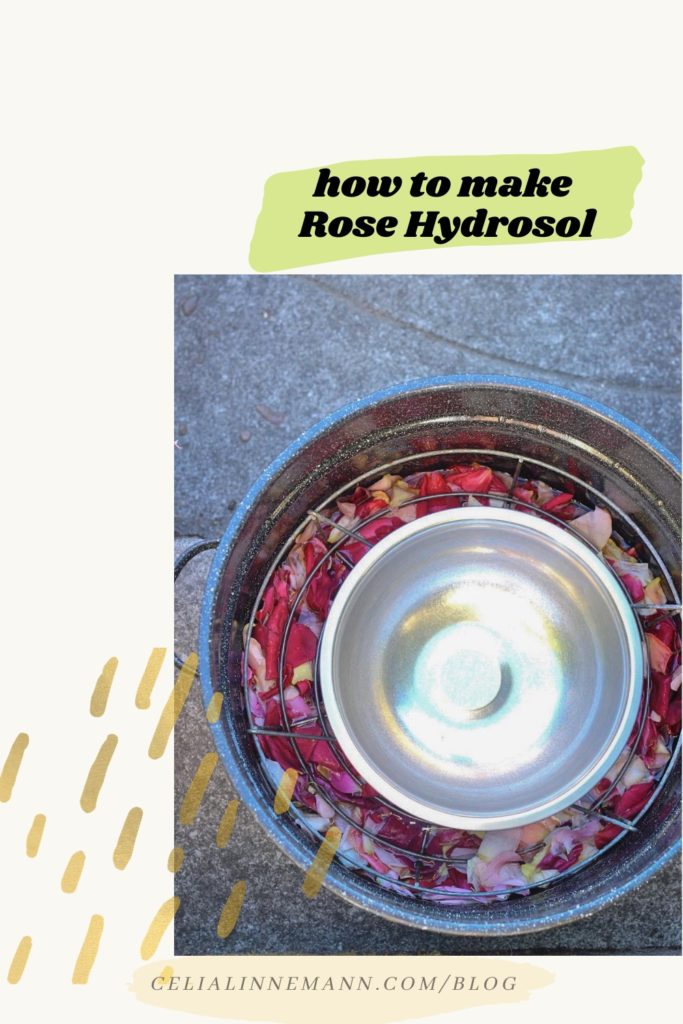
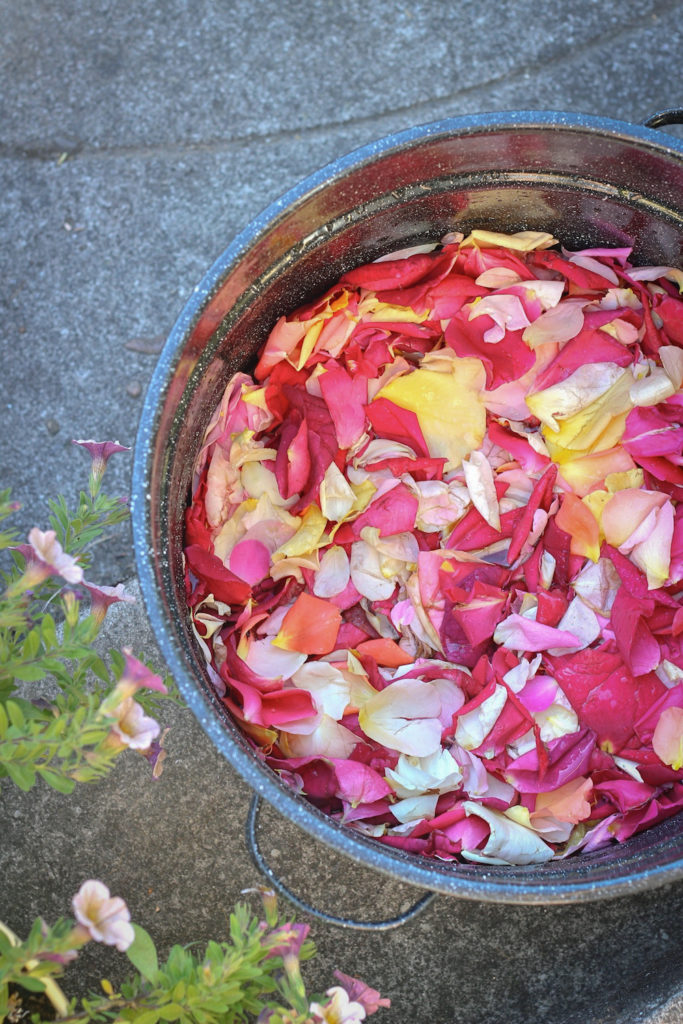
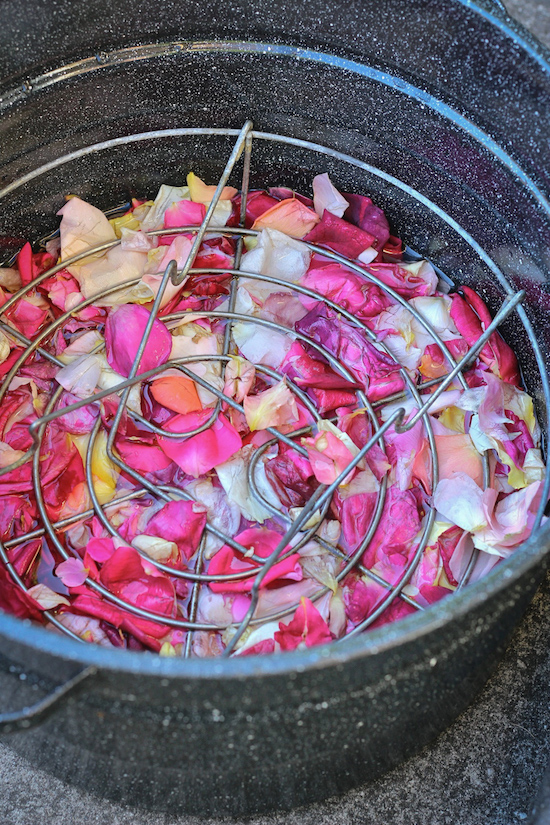
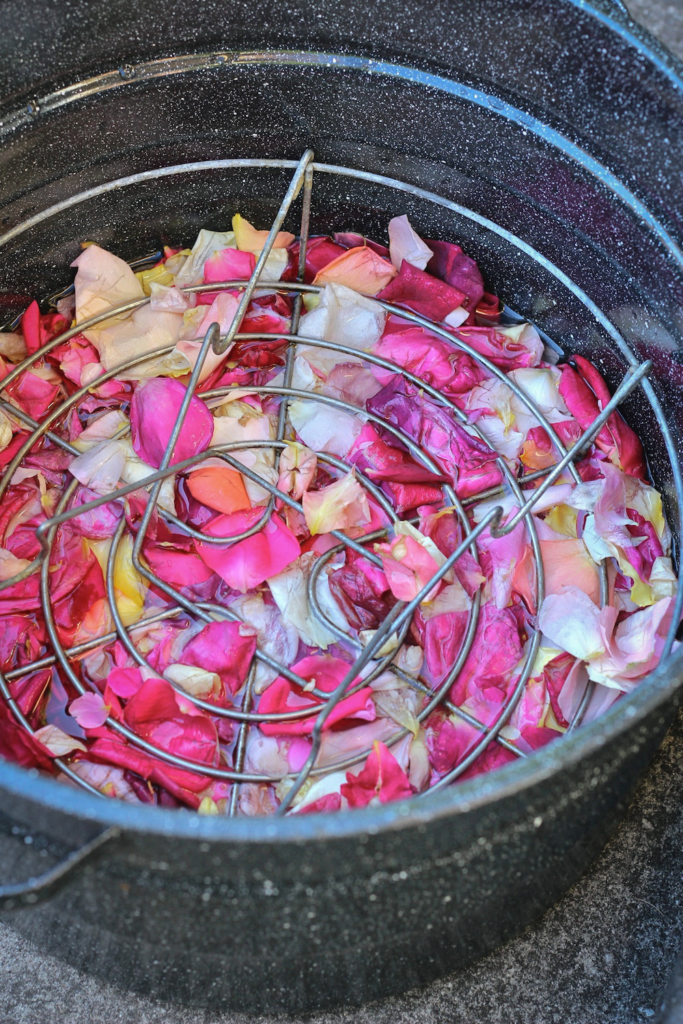

Always be Canner Hydrosol Testing
Always be testing…this is a phrase I use to get used to the practice of failing.
Because most of the time, it’s not failing, it’s experimenting!
I have made a few hydrosol duds.
One of those duds was a batch of Wild Carrot hydrosol, even though the ones before and after were stellar. I think they were not particularly aromatic when I picked them – in an inbetween, second flowering sort of stage.
One of my biggest herbal failures ever was also from making Wild Carrot hydrosol. I harvested a bunch of tops in the vicinity of a train route. Maybe 50 feet away?
As soon as I soaked them I could smell a little bit of oil – as in Diesel. I’m hyper-sensitive to diesel and second guessed myself aka undermined my intuition, and started to make the hydrosol anyway.
As soon as it got to boiling I smelled it again, this time without a doubt.
I brought the canner and herbs straight to the dumpster and aired out my apartment, spent the rest of the day outdoors. Luckily it did not overtly fill my home with Diesel fumes more than it did. That’s straight up toxic material I was bringing into my home.
Lesson learned #1: Trains spew a lot of oil. Don’t get near.
Lesson learned #2: Do a gut check. Listen to your environment and the plants more carefully when you are harvesting.
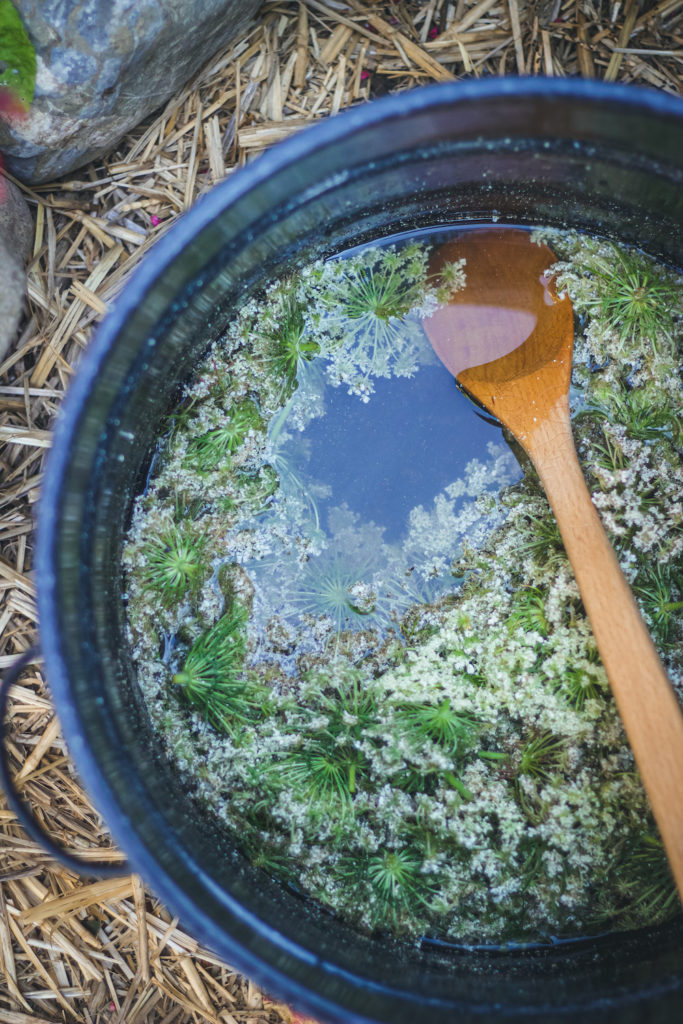
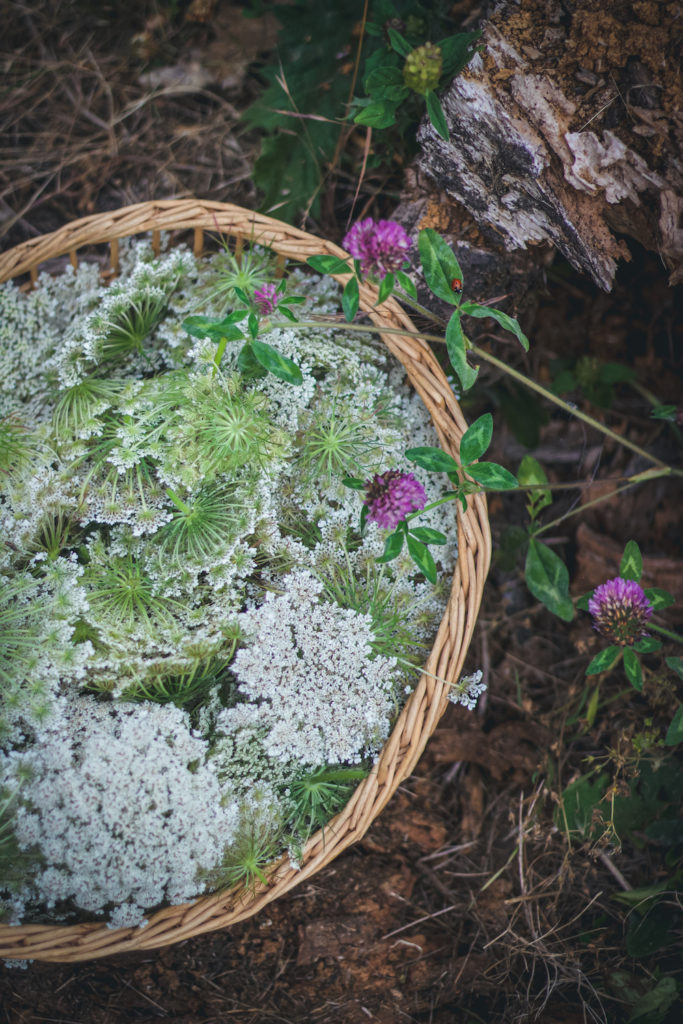
Wild Carrot / Queen Anne’s Lace Hydrosol
I love Wild Carrot hydrosol. One of my favorites by far.
Wild carrot is an abundant weed, so easy to grow and harvest. It’s just asking to be held and gazed upon.
I use both the aromatic white floral umbels and seed-heads in different stages of maturity, but they have to smell good and strong. If I can’t smell them, I don’t pick them.
One summer I made separate hydrosols of the flowers, green seed heads and brown seed heads as a comparison. Remember that always be testing phrase? This applies to playing with herbs, too. In the end I couldn’t elucidate the difference and combined them, because together the aroma and action had more depth.
Wild Carrot hydrosol makes a delicious facial toner. It is even better combined with Yarrow, Rose and Elder tinctures, Rose water, Witch Hazel, and Queen of Hungry’s Water.
One bottle of Wild Carrot hydrosol goes a long way, your face will thank you for years to come.
Queen Anne’s Lace / Wild Carrot Proliferative Action on Skin and Womb
Unfortunately I do not have a lot of written evidence I can quote right now, but I have learned through the years that Queen Anne’s Lace seeds can be used for both reducing fertility and for improving fertility. One person I learned this from was Samantha Zipporah, you can check out her website here.
Regular use of Wild Carrot seeds seem to reduce fertility while you take them, but when you stop taking them, the anecdotal word is that fertility is improved. Isn’t that interesting that Wild Carrot seeds improve function after use?
I need more evidence to make a sound argument, but I think that Wild Carrot has a way helping the body get out with the old, in with the new.
Wild Carrot is slightly irritating on contact and in the body. This irritating nature tends to help the skin (and possibly the mucus membranes) slough. Anything that is worn and old, Wild Carrot will help to usher away. This action is subtle though, at least topically with a hydrosol made from the flowers in blossom and not seed – at least in this form and state, this herb isn’t caustic.
They seems to have a cumulative effect. So regular topical use over time helps to keep the skin fresh and rejuvenated.
Can you see why I just have to have it in my facial toner?!
Wild Carrot/Queen Anne’s Lace and Pregnancy
Queen Anne’s Lace is contraindicated during pregnancy.
Wild Carrot is used as an emmenagogue, a pretty reliable one. In a formula, in small amounts, it is possible yet unlikely that Wild Carrot will cause a spontaneous abortion (the technical term for a miscarriage).
What about external use? Like in a botanical face toner? Or simply picking the plant?
Unfortunately, I don’t have a clear answer if it is using a botanical toner with Wild Carrot in it is totally safe during pregnancy. So I generally recommend not using it.
However, if you DO use it while pregnant, perhaps because you didn’t know not to, I would not worry too much about it. This is a precaution is based on theoretical associations.
Thanks for reading, herb folks.
Best of Wild Carrot and hydrosol cooking days to you all,
Celia

